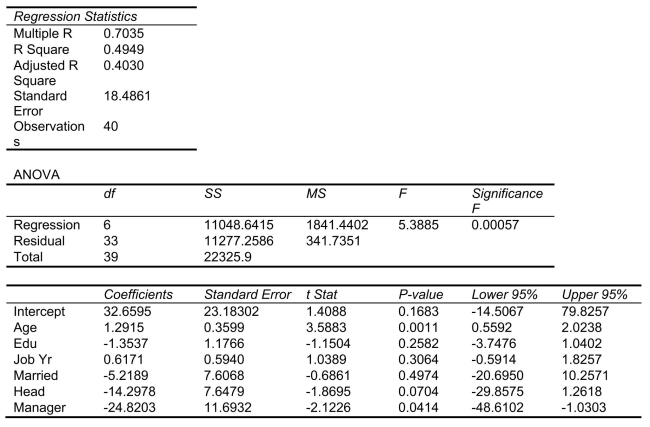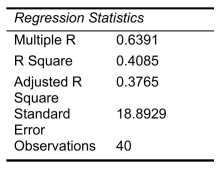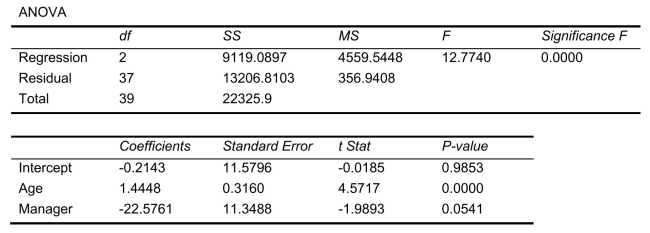SCENARIO 18-10 Given below are results from the regression analysis where the dependent variable is the number of weeks a worker is unemployed due to a layoff (Unemploy)and the independent variables are the age of the worker (Age), the number of years of education received (Edu), the number of years at the previous job (Job Yr), a dummy variable for marital status (Married: 1 = married, 0 = otherwise), a dummy variable for head of household (Head: 1 = yes, 0 = no)and a dummy variable for management position (Manager: 1 = yes, 0 = no).We shall call this Model 1.The coefficient of partial determination  of each of the 6 predictors are, respectively, 0.2807, 0.0386, 0.0317, 0.0141, 0.0958, and 0.1201.
of each of the 6 predictors are, respectively, 0.2807, 0.0386, 0.0317, 0.0141, 0.0958, and 0.1201.  Model 2 is the regression analysis where the dependent variable is Unemploy and the independent variables are Age and Manager.The results of the regression analysis are given below:
Model 2 is the regression analysis where the dependent variable is Unemploy and the independent variables are Age and Manager.The results of the regression analysis are given below: 

-Referring to Scenario 18-10 Model 1, the alternative hypothesis  : At least one of
: At least one of  for j = 1, 2, 3, 4, 5, 6 implies that the number of weeks a worker is unemployed due to a layoff is related to at least one of the explanatory variables.
for j = 1, 2, 3, 4, 5, 6 implies that the number of weeks a worker is unemployed due to a layoff is related to at least one of the explanatory variables.
Definitions:
Restructuring
The corporate action of reorganizing the legal, ownership, operational, or other structures of a company for the purpose of making it more profitable or better organized for its present needs.
Insidious Consequences
Negative outcomes that gradually and subtly develop over time, often as a result of certain actions or decisions.
Organizational Restructuring
The act of realigning or changing the organizational structure, processes, or cultures of a company to improve efficiency, effectiveness, or adapt to new strategies.
Downsizing
The planned reduction of a company's workforce to improve efficiency or reduce costs.
Q6: Referring to Scenario 16-14, in testing the
Q9: <img src="https://d2lvgg3v3hfg70.cloudfront.net/TB8562/.jpg" alt=" indicates that if
Q86: Which of the following is NOT one
Q89: Referring to Scenario 16-4, construct a centered
Q107: Which of the following investigates what should
Q135: Referring to Scenario 16-14, using the regression
Q174: Referring to Scenario 18-9, _ of the
Q237: Referring to Scenario 18-2, what is the
Q251: Referring to Scenario 18-2, the estimated value
Q266: A powerful women's group has claimed that